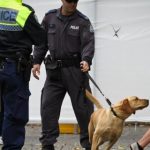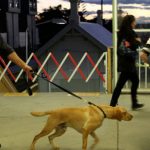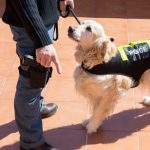Is a Positive Indication by a Sniffer Dog Enough for Police to Search You? Part 1: “Reasonable Suspicion”

We have posted numerous articles and videos about the fact that police cannot undertake random or arbitrary searches upon people – they must have a ‘suspicion on reasonable grounds’ before performing a search.
This two-part blog aims to answer the question – is the fact that a sniffer dog sat next to me enough by itself to ground a reasonable suspicion?
The question will be answered by:
Part 1. Describing the legal test, and
Part 2. Outlining the available empirical data and applying it to the legal test.
Here’s part 1: What does the law say about ‘reasonable suspicion’ and the use of sniffer dogs for drug detection?
1. Applicable law
A. Legislation
The starting point is section 21(1) of the Law Enforcement (Powers and Responsibilities) Act 2002 (LEPRA or ‘the Act’) which says:
A police officer may, without a warrant, stop, search and detain a person, and anything in the possession of or under the control of the person, if the police officer suspects on reasonable grounds that any of the following circumstances exists:
(a) the person has in his or her possession or under his or her control anything stolen or otherwise unlawfully obtained,
(b) the person has in his or her possession or under his or her control anything used or intended to be used in or in connection with the commission of a relevant offence,
(c) the person has in his or her possession or under his or her control in a public place a dangerous article that is being or was used in or in connection with the commission of a relevant offence,
(d) the person has in his or her possession or under his or her control, in contravention of the Drug Misuse and Trafficking Act 1985 , a prohibited plant or a prohibited drug.
So in a nutshell, police can perform a search without a warrant if they suspect ‘on reasonable grounds’ that you are in possession of something stolen or illegal, or something used or to be used in ‘relevant offence’ (whether it be a dangerous article or not), or a prohibited plant or drug.
The most relevant subsection for present purposes is of course ss(d).
But the sake of completeness, section 20 of the LEPRA provides the following very broad definition of ‘relevant offence’:
(a) indictable offences (ie any offence that can be dealt with in a higher court, which covers hundreds of criminal offences)
(b) an offence against section 93FB of the Crimes Act 1900 (ie possession of dangerous articles other than firearms)
(c) an offence against the Weapons Prohibition Act 1998 , the Firearms Act 1996 , or a regulation made under either of those Acts (which prescribe a wide range of weapons and firearms offences)
(d) an offence against a provision of Part 2 of the Explosives Act 2003 (eg handling or conveying explosives)
For the purpose of 21(1)(d) the Act defines ‘dangerous article’ as:
(a) a firearm, a spare barrel for any such firearm, or any ammunition for any such firearm, or
(b) a prohibited weapon within the meaning of the Weapons Prohibition Act 1998 , or
(c) a spear gun, or
(d) an article or device, not being such a firearm, capable of discharging by any means:
(i) any irritant matter in liquid, powder, gas or chemical form or any dense smoke, or
(ii) any substance capable of causing bodily harm, or
(e) a fuse capable of use with an explosive or a detonator, or
(f) a detonator.
B. Use of sniffer dogs generally
Part 11 Division 2 (sections 145 to 150) of the LEPRA gives police the power to use ‘drug detection dogs’ for the purpose of detecting drug offences.
Section 148(1) allows police to use sniffer dogs without a warrant in relation to:
(a) persons at, or seeking to enter or leave, any part of premises being used for the consumption of liquor that is sold at the premises (other than any part of premises being used primarily as a restaurant or other dining place),
(b) persons at, or seeking to enter or leave, a public place at which a sporting event, concert or other artistic performance, dance party, parade or other entertainment is being held,
(c) persons on, or seeking to enter or leave, a public passenger vehicle that is travelling on a route prescribed by the regulations, or a station, platform or stopping place on any such route,
(d) persons at, or seeking to enter or leave, any part of premises that the officer is authorised to enter under the Tattoo Parlours Act 2012 to carry out general drug detection using a dog,
(e) persons at any public place in the Kings Cross precinct (being the area including and bounded by the parts of streets specified in Schedule 2 to the Liquor Act 2007 ).
So in summary, police can use sniffer dogs:
– In or outside pubs, clubs and bars but not venues that are primarily used as restaurants,
– In or outside sporting grounds, concert venues, theatres, dance parties and parades,
– On or near public transport and taxis,
– At or outside tattoo parlours, and
– In the Kings Cross precinct.
Section 150 requires police to take all reasonable precautions to prevent sniffer dogs from touching a person and to keep them under control.
There is nothing in the LEPRA that says a police officer can search someone if a ‘drug detection dog’ gives a positive indication eg sits next to them.
3. Leading case on ‘reasonable suspicion’
Although it was concerned with the predecessor to section 21 (s.357E of the Crimes Act), the leading authority on the meaning of reasonable suspicion when it comes to personal searches without a warrant in NSW is the New South Wales Court of Criminal Appeal decision of R v Rondo (2001) 126 A Crim R 562.
That case was presided over by Chief Justice Spigelman, and Justices and Simpson and Smart.
The most pertinent (and most frequently quoted) part of the judgment is paragraph [53] where, after reviewing several authorities, Justice Smart finds that ‘the following propositions emerge’:
(a) A reasonable suspicion involves less than a reasonable belief but more than a possibility.
There must be something which would create in the mind of a reasonable person an apprehension or fear of one of the state of affairs covered by s.357E.
A reason to suspect that a fact exists is more than a reason to consider or look into the possibility of its existence.
(b) Reasonable suspicion is not arbitrary. Some factual basis for the suspicion must be shown.
A suspicion may be based on hearsay material or materials which may be inadmissible in evidence. The materials must have some probative value.
(c) What is important is the information in the mind of the police officer stopping the person or the vehicle or making the arrest at the time he did so.
Having ascertained that information the question is whether that information afforded reasonable grounds for the suspicion which the police officer formed. In answering that question regard must be had to the source of the information and its content, seen in the light of the whole of the surrounding circumstances”.
Key parts of Justice Smart’s summation are:
– To form a reasonable suspicion, there must be “more than a possibility” that a person possessed drugs and this must be “more than a reason to consider or look into the possibility of its existence”.
– “Reasonable suspicion is not arbitrary. Some factual basis for the suspicion must be shown”.
– When determining whether there was reasonable suspicion, “regard must be had to the source of the information and its content, seen in the light of the whole of the surrounding circumstances”.
That’s a summary of the current state of the law.






